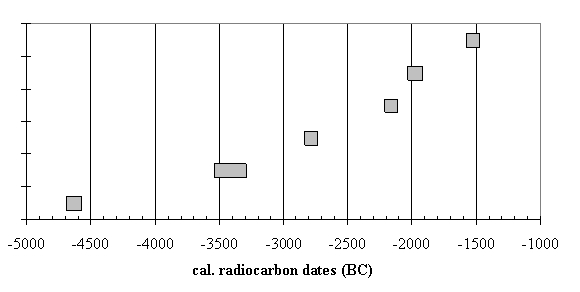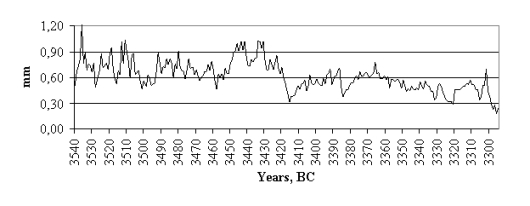The sampling sites of subfossil European ash Fraxinus excelsior L. wood are located in Western Lithuania. The research was carried out in two bogs expecting to find oak wood for dendrochronological studies. In total, 14 ash samples were collected, and seven samples were radiocarbon dated. Twelve samples of the ash were suitable for dendrochronological analysis. Because of poor preservation, two samples were not measured. The investigations have shown that the ash trees belong to different age categories: from 59 to 238 rings. The ring widths among samples varied from 0.44 to 0.78 mm. The radial growth of the ash is characterized by low, medium, or high mean sensitivity (0.13–0.32).

The cross-dating of 12 ash series derived for each sample enabled six floating mean curves to be constructed, spanning 98 to 246 years and including one to four samples. They are radiocarbon dated to 4688–4576 BC, 3540–3295 BC, 2829–2730 BC, 2209–2112 BC, 2030–1913 BC, and 1573–1471 BC. Hence, the ash trees grew in the Late Atlantic and Subboreal periods (approximately 4700–1500 BC).
Abrupt growth depressions occurring every 40–60 years are common for three of the mean curves (3540–3295 BC, 2209–2112 BC and 2030–1913 BC). In addition, a long downward trend is typical of four curves dated to 4688–4576 BC, 3540–3295 BC, 2209–2112 BC and 1573–1471 BC. The trees in 4688–4576 BC, 3540–3295 BC, and 2209–2112 BC have indicated a sharp growth reduction before the die-off. A sharp reduction of the growth in the tree-ring series indicates a constant worsening of the growth conditions connected to the bog hydrological regime caused by a rise in the water level.


The lifetime of the ash trees, especially in 4688–4576 BC, 3540–3295 BC and 2829–2730 BC, corresponds to the phases of bog oaks’ prevalence in Western Europe (Leuschner and Sass-Klaassen, 2003; Spurk et al., 2002). It indicates that investigated ash trees were under the control of large-scale climate changes involving wide areas of Europe. The current study extends our knowledge on the growth of ash in the Holocene, pointing to the bigger age of trees in former times and that they were perhaps more widely distributed in different periods of the Holocene than has been established using palynological data.